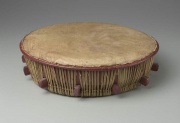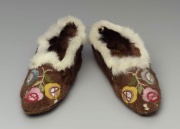Difference between revisions of "Animal skin"
Jump to navigation
Jump to search
| Line 2: | Line 2: | ||
== Description == | == Description == | ||
| − | The raw or dressed skin of a small animal such as a pig, [[goat|goat]], sheep, or calf. A freshly slaughtered skin contains about 65% water and 33% protein (Kuhn 1986). Small amounts of other materials, such as fats, carbohydrates, and minerals, are also present. Tanning chemically changes the skin and makes it resistant to putrefaction. | + | The raw or dressed skin of a small animal such as a pig, [[goat|goat]], sheep, or calf. A freshly slaughtered skin contains about 65% water and 33% protein (Kuhn 1986). Small amounts of other materials, such as fats, carbohydrates, and minerals, are also present. Tanning chemically changes the skin and makes it resistant to putrefaction (see [[leather]] and [[parchment]]). |
| − | See also [[buckskin|buckskin]], [[calfskin|calfskin]], [[capeskin|capeskin]], [[deerskin|deerskin]], [[doeskin%20leather|doeskin]], [[fish%20skin|fish skin]], [[goatskin|goatskin]], [[hide|hide]], [[kangaroo%20skin|kangaroo skin]], [[kidskin|kidskin]], [[lambskin|lambskin]], [[lizard%20skin|lizard skin]], [[moleskin|moleskin]], [[pigskin|pigskin]], [[salmon%20skin|salmon skin]], [[sealskin|sealskin]], [[sharkskin|sharkskin]], and [[snakeskin|snakeskin]]. | + | See also [[buckskin|buckskin]], [[calfskin|calfskin]], [[capeskin|capeskin]], [[deerskin|deerskin]], [[doeskin%20leather|doeskin]], [[fish%20skin|fish skin]], [[goatskin|goatskin]], [[hide|hide]], [[kangaroo%20skin|kangaroo skin]], [[kidskin|kidskin]], [[lambskin|lambskin]], [[lizard%20skin|lizard skin]], [[moleskin|moleskin]], [[pigskin|pigskin]], [[salmon%20skin|salmon skin]], [[sealskin|sealskin]], [[sharkskin|sharkskin]], [[sheepskin]], and [[snakeskin|snakeskin]]. |
[[File:97.157-SC16174.jpg|thumb|Womens shoes<br>MFA# 97.157]] | [[File:97.157-SC16174.jpg|thumb|Womens shoes<br>MFA# 97.157]] | ||
Revision as of 12:28, 17 August 2020
Description
The raw or dressed skin of a small animal such as a pig, Goat, sheep, or calf. A freshly slaughtered skin contains about 65% water and 33% protein (Kuhn 1986). Small amounts of other materials, such as fats, carbohydrates, and minerals, are also present. Tanning chemically changes the skin and makes it resistant to putrefaction (see Leather and Parchment).
See also Buckskin, Calfskin, Capeskin, Deerskin, doeskin, Fish skin, Goatskin, Hide, Kangaroo skin, Kidskin, Lambskin, Lizard skin, Moleskin, Pigskin, Salmon skin, Sealskin, Sharkskin, Sheepskin, and Snakeskin.
Synonyms and Related Terms
skin; hide; piel (Esp.); cuero animal (Esp.); pele animal (Port.); huid van een dier of dierenhuid (Ned);
Resources and Citations
- Hermann Kuhn, Conservation and Restoration of Works of Art and Antiquities, Butterworths, London, 1986

